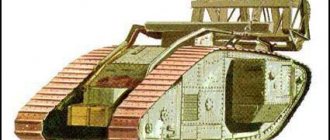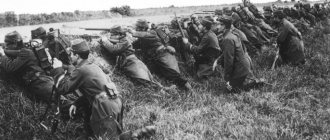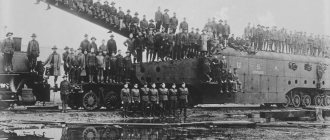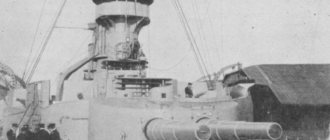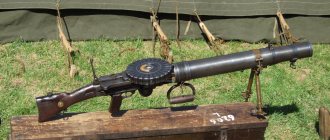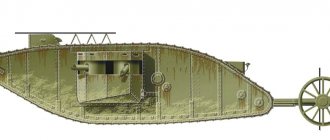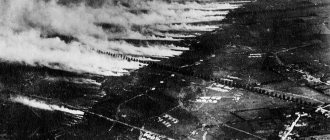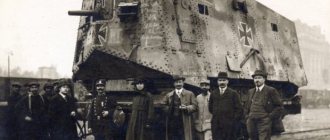As a result of the First World War, 4 empires collapsed at once: Russian, German, Austro-Hungarian and Ottoman. Yes, our country ended up in the camp of the winners, but it emerged from the conflict with two revolutions and the ongoing Civil War.
The largest battle and most impressive victory of the Russian army in the First World War was the Brusilovsky breakthrough, during which the casualties of both sides amounted to almost 2 million people. Our troops defeated the Austrians, Germans and Turks, and also advanced approximately 120 kilometers deep into enemy territory. It was after the Brusilov breakthrough that the strategic initiative finally passed from the Central Powers to the Entente.
Brusilov's personality
General Brusilov took command of the Southwestern Front in 1916. His appointment is interesting because he was one of the few generals in high-ranking positions who was not close to the General Staff and the Government. Brusilov was a talented general, who was talked about not only in Russia, but also in Europe. The soldiers loved him. The General Staff did not like him because what distinguished him from most of the staff officers was that Brusilov had real combat experience. Moreover, the experience is positive. His appointment to the Southwestern Front can only be explained by the fact that it was the most difficult sector, where a real military general was needed to wage war, and not a puppet.
In the first days after his appointment as commander of the Southwestern Front, Brusilov received Nicholas 2, who personally came to look at the condition of the troops. In his diaries, Brusilov described his meeting with the emperor as follows.
Nikolai 2 asked if I had information that he should know. I replied that I had a very serious report. I do not share the views of the previous front command, which reported to you that the army was not able to advance. On the contrary, I am convinced that a few months of rest gave the soldiers a respite, after which they were ready for battle. By May 14, the troops of the Southwestern Front will be fully ready for an offensive to seize the initiative in the war. If the command believes that our front should not advance, then my appointment to the post of commander is useless and even harmful. I see opportunities for attack and am ready to implement the plan in accordance with the requirements of Headquarters
General Brusilov
Meeting at Headquarters
On April 14, 1916, a meeting was held at Headquarters (the city of Mogilev) at which plans for the 1916 military campaign were discussed. Heading the meeting is General Alekseev. Based on his experience, he initially believed that the offensive should be carried out by the Northern and Western Fronts. Brusilov and his army, according to the plan, were supposed to hold the defense, since the enemy had an advantage in their sector of the front. The commanders of the Western and Northern Fronts were against the offensive, pointing out that the experience of the battles of 1915 shows that an offensive is impossible and it is necessary to take up defensive positions. The reason why generals Kuropatkin and Evert refused to attack was because the Russian army was sorely lacking heavy artillery pieces.
General Brusilov, speaking at Headquarters, emphasized the following points:
- The front needs additional shells, heavy guns and aircraft. But even in its current configuration, the army is ready to fulfill its mission and attack.
- The reasons for the unsuccessful offensives of recent years lie in improper organization. For example, the priority direction of attack was chosen without camouflage, and the remaining units were inactive . As a result, the enemy had a numerical minority, but painlessly transferred divisions to the direction of the main attack, forming his own superiority there.
- Only a joint offensive on all fronts can be effective, when the enemy has no room for maneuver.
I cannot speak for other sectors of the front, but on the South-Western there are all the conditions for an offensive. I ask permission for the troops of my front to act in a joint attack with the armies of Evert and Kuropatkin. Even if I do not achieve success, we will tie up the main enemy forces, which will make the task easier in the West and North.
Brusilov, report at Headquarters, June 14, 1916
Note that Brusilov is deliberately betting that the Southwestern Front is ready to attack. After all, if an army is ready to attack, against which approximately equal enemy forces are assembled, then other armies that already have an advantage over the enemy must also be ready to go on the attack. As a result, all front commanders supported the idea of a joint attack.
Artillery attack. Start of attack
On June 4, at 3 a.m., artillery preparation began. Its power was calculated individually, the fire lasted from 6 to 45 hours. In the Lutsk direction, with very strong fortifications, the artillery did not stop for 29 hours. Enough penetrations were made in the wire fences, the 1st line of defense was completely swept away. Keeping the rate of fire, the batteries fired not at the officers' signals, but like this: the gunners, holding the cords and looking at each other, fired a burst behind the right-flank gun. Having studied the enemy’s defense tactics, we inflicted maximum losses on him even before the start of the attack, twice falsely stopping the shelling of the 1st lane. This usually means infantry is attacking. The Austrians fled from shelters into the trenches, to the machine guns, and the barrage of fire returned. The third time, the enemy no longer dared to leave the shelters, and the infantry arrived in droves and took the hidden prisoners prisoner, which explains their huge number.
There was not a second's break between the artillery barrage and the assault. Heavy artillery carried fire into the depths, to the 3rd line of defense. The light one hit the targets until the last moment, and when the infantry burst into them, some of the batteries cut off counterattacks from the front and flanks, and some followed the infantry, punching its path with shells. This was the main tactical novelty - for the first time in the First World War, infantry escort artillery appeared and worked “excellently”, the independence and survivability of which immediately increased. Previously, she suffered heavy losses under enemy fire. But by shooting, he inevitably reveals himself - now the guns “extinguished” enemy cannons and machine-gun nests after their first shots.
Start of attack Source: Pinterest
The front burst in 13 areas at once, the breakthrough expanded towards the flanks and in depth. We took care of consolidation in the taken positions and continuity of the offensive, so that the enemy, who fell into panic, did not organize active countermeasures. To do this, the advancing infantry was divided into “attack waves.” Each regiment formed 4 waves, moving one after another at a distance of 150-200 steps, the interval between fighters was 5 steps. Armed with grenades, machine guns, smoke bombs, and wire cutters, the first two waves took the first trench, did not linger, attacked the second, where they consolidated. This was done taking into account enemy tactics. He usually opened fire on the Russians who had broken through and were stuck in the first trench. Then the heavy batteries cut off the approach of help - and with a powerful counterattack those who broke through were exterminated. But now each company had an assault group of the most agile soldiers. Walking at the head of the attack, they eliminated firing points with grenades and massive rifle and machine-gun fire, clearing the way for their advancing comrades. The third and fourth waves quickly rolled over the first two, and with fresh forces took the third trench and artillery positions. This method later became widely used under the name “roll attack.”
The 6th Corps worked perfectly, taking all three lines of trenches on the move, defeating not the Austrians, but the Germans. Everything was done so clearly that even the deep shelters, which became traps, were not saved. The Russians were right there, grenades and smoke bombs flew down, there were almost no survivors. The soldiers sitting in the surviving shelters hastily surrendered. Standing at the entrance, the Russian “cleaner” would throw hand grenades inside if he refused to surrender or even hesitated. Quickly realizing this, the enemy quickly climbed up with his hands raised. The prisoners gave the following picture of losses: in the 1st line of trenches - 85 percent killed and wounded and 15 percent prisoners; in the 2nd line - 50 percent of each category; in the 3rd line - all 100 percent of prisoners.
Preparing a breakthrough
General Brusilov believed that the problem of the offensive was related solely to the direction of the main attack. To prepare a bridgehead, dig trenches, deliver supplies, and assemble artillery, a minimum of 6 weeks is needed. It is almost impossible to hide all these preparations from the enemy. Brusilov's plan assumed that each section of the Southwestern Front would prepare several bridgeheads (from 20 to 30) for the offensive. This was supposed to confuse the enemy and prevent him from concentrating his main forces on the direction of the actual offensive.
The general plan for the Brusilov breakthrough was briefly summarized as follows:
- The main blow should be delivered by the 8th Army, located on the right wing. Artillery and manpower reserves were secretly transferred to the 8th.
- The remaining sectors begin a local breakthrough in their direction, pinning down the enemy.
The direction of the main attack is Lutsk.
Assault on Chernivtsi
The 11th and 7th armies also broke through the front, but the enemy stopped their offensive. Brusilov did not withdraw reserves from other directions, but ordered: “Fight to the death!” You can't close all the holes. Break through in the right place, but in others the enemy himself will not be able to stand it, he will run.”
The 9th Army crushed the 7th Austrian Army, by June 13 it had broken through 50 km, and on June 18 it stormed Chernivtsi, called the “second Verdun” for its inaccessibility: solid reinforced concrete, a jungle of barbed wire with a current running through it, artillery up to a caliber of 305 mm. The enemy could have defended himself for a long time, but he broke down morally. The panic began. Having blown up bridges across the Prut, the garrison burned and blew up warehouses, trains on the tracks, and heavy batteries. The city fell, and the entire southern flank of the Austrian front was breached. The enemy retreated so hastily that they blew up the bridges, leaving their own on the Russian bank.
Features of enemy defense
In front of the Southwestern Front of General Brusilov, the army of Austria-Hungary was mainly located, reinforced by units from Germany. Aerial reconnaissance showed that the enemy had created at least three fortified zones, with an average distance of 5 km between them. The depth of each strip is approximately 2 km. Each strip consisted of at least 3 lines of trenches taller than a man. A wire was stretched in front of each strip (up to 8 rows). In some areas, high-strength steel wire was stretched and could not be cut. In some areas, mainly in front of the first line of defense, a high voltage current was passed through the wire. Bombs were hung on wires. Landmines are laid in front of them. Every 90 meters there were firing points and loopholes for machine guns.
Balance of forces and means
By the time the offensive began, the troops of the Southwestern Front, under the command of General Brusilov, were positioned so as to deliver several attacks, disguising the main breakthrough to the right flank.
Table: Disposition of troops of the Southwestern Front at the beginning of the Brusilov breakthrough
| 8th Army: 14 infantry divisions, 7 cavalry divisions. A total of 225 thousand people, 716 guns (76 heavy). | 4th Austrian Army: 13 infantry divisions, 3 cavalry divisions. Total: 145 thousand people, 550 guns (174 heavy). | ||
| Center (to the right) - towards Brody | 135 | 11th Army: 4 army corps, 1 cavalry division. Total: 130 thousand people, 380 guns (22 heavy). | 2nd Austrian Army and German Corps: 10 infantry divisions, 2 cavalry divisions. Total: 135 thousand people, 470 guns (160 heavy). |
| Center (to the left) - to Galich | 63 | 7th Army: 7 infantry divisions, 3 cavalry divisions. Total: 110 thousand people, 355 guns (23 heavy). | 7 infantry divisions, 1 cavalry division. A total of 85 thousand people, 325 guns (62 heavy). |
| Left flank - to Chernivtsi | 90 | 9th Army: 10 infantry divisions, 4 cavalry divisions. Total: 165 thousand people, 495 guns (47 heavy). | 7th Austro-Hungarian Army: 9 infantry divisions, 4 cavalry divisions. Total: 110 thousand people, 500 guns (150 heavy). |
The Russian army also had a reserve in the form of 3 infantry and 1 cavalry divisions.
Capture of Lutsk
The most significant success was achieved by the 8th Army with its greatest density of attackers, the front of each division was only 2.5 versts. It wedged itself between the 2nd and 4th Austrian armies (the latter was utterly defeated by June 15), already in the first days achieving such successes as none of the allied armies had ever achieved: on a front of 80 km, Austrian positions were broken through to 30 km in depth.
During the first days of fierce fighting, the troops pushed the enemy back across the Styr River, after which on June 7, the 16th Infantry Regiment of the Iron Division burst into Lutsk on the shoulders of the fleeing enemy. Lutsk was completely taken after a heavy night battle by units of the 15th Infantry Division of General. P. N. Lomnovsky (8th Corps) and the 4th Infantry Division (40th Corps) General. A. I. Denikina. One of the first to rush into Lutsk was the commander of the 15th automobile machine gun company, St. George's Cavalier, Staff Captain Syroboyarsky, who was seriously wounded in the battle for Lutsk.
Russian army Source: Wikimedia Commons
Progress of the operation
The Brusilov breakthrough began on June 4, 1916 with artillery preparation in the early morning. The task of artillery is to inflict maximum damage on enemy defenses. Thus, by the evening of June 4, almost all the barbed wire barriers in the direction of advance of the 8th Army were destroyed. An indicative example is the artillery shelling on the front of the 9th Army. The shelling began on the positions of the first trench. The enemy ran deeper into cover. After the artillery shifted its fire deeper into the defense, the Austro-Hungarian army rushed to the trenches, preparing to repel the infantry advance. At this moment, the artillery again transferred fire to the front trench, forcing the enemy 7th Army to flee into the “fox holes” and hide from the shelling. This continued 4 times, and on the 5th time, when the artillery again transferred fire into the depths of the enemy stronghold, the Austro-Hungarian troops did not occupy the first trench, expecting that the Russian artillery would begin shelling it again. As a result, the Russian infantry went on the offensive and captured the enemy's first echelon of defense almost without resistance.
Artillery preparation in different sectors of the front lasted:
- 8th Army - 29 hours
- 11th army - 6 hours
- 7th Army - 45 hours
- 9th army - 8 hours
Only after this did the infantry advance begin. The success of the Brusilov offensive was amazing. By the end of June, the offensive was successful in the territory from Pripyat to the border with Romania. The Russian army occupied Bukovina and the cities of Chernivtsi, Lutsk and others. In the direction of Kovel, the Russian army advanced 70 km inland! This was an amazing success, since the First World War at the stage of 1915-1916 came down to a positional struggle, where a huge success was to move forward just 1 kilometer. Realizing the complexity of the situation, and seeing little activity on other fronts, the German command began to transfer additional forces to suppress the Brusilov breakthrough. In total, in the summer of 1916, the following were transferred to this section of the front:
- 36 German divisions
- 9 divisions of Austria-Hungary
- 2 divisions of Turkey.
It is noteworthy that 11 divisions were withdrawn from the French front, and 9 from the Italian front. A German steel division, which had not known defeat, was transferred from the French direction. On the Brusilov front it was defeated in just a few days.
Offensive development
On June 24, the command additionally transferred the 3rd Army, which was inactive on the flank of the Western Front, to the Brusilov Front. Using reinforcements, General Brusilov adjusted the action of the army, setting the following tasks:
- Right flank (8th and 3rd armies) - offensive in the direction of Kovel and Vladimir-Volynsky.
- Left flank (7th and 9th armies) - attack on Galich, moving towards the Carpathians.
- Center (11th Army) - holding positions and local offensives in the direction of Brody.
Brusilov's plan thwarted the offensive of the Germans, who planned to strike the Russian army in the flank in the Kovel direction. The actions of the 3rd and 8th Russian armies eliminated this opportunity. Already by July 14, these armies, during the offensive, reached the shores of Stokhod. At the same time, the 9th Army advanced deeper, when no more than 20 km remained to Stanislav. The remaining armies managed to repel the enemy's counterattack and hold their starting points.
The third wave of the breakthrough lasted from July 28 to August 14, completing the Brusilov offensive. In August, the battles were local, with mutual successes, however, the main thing was achieved - the army of the Russian Empire made significant progress and managed to gain a foothold in the conquered territories.
Losses of the parties
The results of the Brusilov breakthrough were excellent for Russia, but the losses were also huge.
More than 262 thousand people were killed in the direction of the breakthrough alone. In total, more than 2 million people were killed, wounded and missing. Table: Losses of the parties following the Brusilov breakthrough of the Russian army in 1916
| Side | Killed | Wounded | Missing |
| Quadruple Alliance | |||
| Germany | 28 858 | 195 540 | 38 095 |
| Austria-Hungary | 45 058 | 216 474 | 377 799 |
| Türkiye | 5 000 | 3 000 | 2 000 |
| Russia | |||
| Russia | 262 764 | 1 562 890 | 214 607 |
Please note that the table presents data on total losses on all fronts. If we specify the data on losses on individual fronts in Russia, the figures will be as follows:
- Southwestern Front - 202 thousand people killed
- Western Front - 44 thousand people killed
- Northern Front - 9.6 thousand people killed.
First stage
On May 22 (old style) artillery preparation began, which lasted more than two days. As a result, the enemy's first line of defense was severely destroyed, and his artillery was partially neutralized. The Russians began to advance and on June 7 occupied Lutsk, and 11 days later Chernivtsi, which was well fortified and was called by the Austrians “the second Verdun” for its inaccessibility.
The attitude of the front and its command turned out to be decisive in the development of success, so it was the South-Western direction that quickly became the leading one. Brusilov's soldiers were the first to break through the massive defense and began to rapidly advance further. The general managed to ensure the surprise of the offensive, which is important for any battle. The enemy considered his fortifications too powerful and did not expect a breakthrough. It had a defense in depth of three lines with strong points and continuous trenches between them, the approaches to which were shot from the flanks. There are pillboxes at all heights. Cut-off positions went deeper from some nodes, so even the attackers who broke through ended up in the bag. Concrete vaults of dugouts, concrete caps for machine gunners, wire barriers with mines and electric current passed through them - for the first time, the Russians were able to overcome such powerful barriers.
Brusilov decided to break through in 4 places at once - this also came as a surprise to the enemy. On the one hand, he scattered his forces, but the enemy could not effectively use his reserves. The general constantly changed the direction of his attacks and repeatedly switched from attack to defense, which completely confused the enemy.
On June 24, the British and French began artillery preparation on the Somme and 7 days later went on the offensive. The Russians tried to capture Baranovichi, but the strike group of the Western Front was repulsed with heavy losses for our army.
Alexey Alekseevich Brusilov
Results and significance of the Brusilov breakthrough
The Brusilov breakthrough was a unique event in the First World War. Suffice it to say that this is the only operation of that war named after the general. The results of the offensive of Brusilov’s army were impressive:
- The Russian army liberated an area of 25 thousand square kilometers.
- Captured: 370 thousand soldiers and 8.2 thousand officers.
- 496 artillery pieces and 367 mortars/bomb throwers were captured.
- The number of captured machine guns and firearms could not be counted.
At the base of the breakthrough, the Russian army continued to advance, but at a much slower pace. However, by the end of September 1916, the number of prisoners increased to 420 thousand soldiers and 9 thousand officers, and the number of captured guns and mortars increased to 1.2 thousand.
The Brusilov breakthrough brought about a radical change in the First World War. If before the start of the military operation the strategic initiative was on the side of Germany, then by September 1916 the initiative was completely on the side of the Entente countries. Such advances as those shown by the army of General Brusilov’s Southwestern Front did not occur within the framework of a positional war.
For Germany, the events of 1916 demonstrated the impossibility of waging a successful war on 2 fronts. Many German officers no longer believed in the possibility of victory. For this reason, the Chief of the German General Staff, General Falkenhayn, was removed from his post. He was replaced by General Hindenburg.
The Austro-Hungarian army, which was mainly located on the path of Brusilov’s army, was defeated. Austria-Hungary was effectively withdrawn from the war, and Germany was forced to devote a significant portion of its resources (both human and financial) to supporting its ally. This significantly weakened Germany itself.
Why the Brusilov breakthrough did not lead to the defeat of the enemy
By the end of June 1916, the Brusilov breakthrough had already produced phenomenal results. General Brusilov believed that in the coming months it would be possible to defeat the enemy and end the war. However, there were 2 factors that allowed the Germans to endure the severity of the defeat:
- Lack of offensive, especially on the Western Front. The Western Front, which, according to the plan of the Russian General Staff, was supposed to deliver the main blow, refrained from a massive offensive, even seeing the successes of Brusilov’s army.
- Lack of help from allies. After the start of the Brusilov breakthrough, the offensive of Russia's Entente allies on the Somme began on the German Western Front. But this offensive was of such a local nature that it did not pose any threat to the Germans. Moreover, Germany regularly withdrew troops from the Western Front and transferred them to the East.
The situation in the summer of 1916 really contributed to the defeat of Germany, but the identified 2 factors allowed Germany to survive the defeat and regain strength.
Sources and additional material on the topic:
- “The First World War” - Utkin A.I. Moscow, 2002
- “Debatable problems of history” - Pisarev Yu.A. Moscow, 1994
- "PMV" - Oskin M.V. Moscow, 2010
